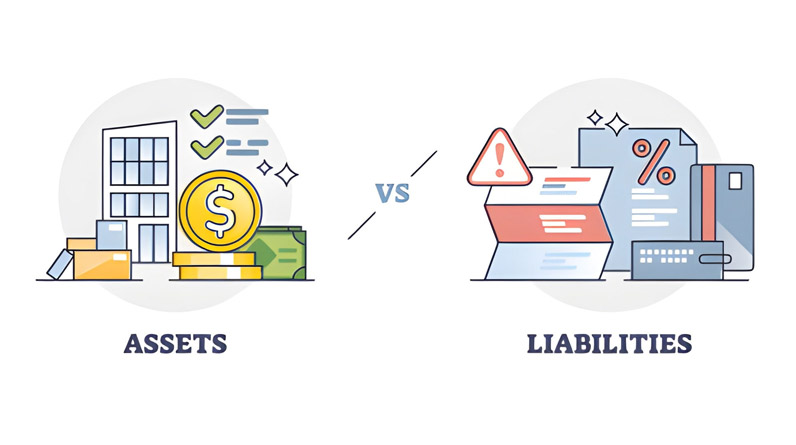Every day, millions of people work hard, earn money, and wonder why they’re not getting ahead financially. The answer often lies in a fundamental misunderstanding of two simple concepts: assets and liabilities. While these terms might sound like accounting jargon, they represent the difference between financial freedom and lifelong financial struggle.
The truth is, your financial future isn’t determined by how much you earn—it’s determined by how well you understand and manage the relationship between what you own and what you owe. This article explores not just the technical definitions, but the life-changing implications of truly grasping this difference.
What Are Assets? More Than Just Things You Own
At its core, an asset is a resource with economic value that you own or control, expecting it to provide future benefits. However, this definition only scratches the surface of what makes something a true asset.
The Two Perspectives on Assets
The Accounting Perspective: In traditional accounting terms, assets are resources listed on the left side of a balance sheet. They include everything from cash in your bank account to the equipment in your business. Assets are categorized as:
- Current Assets: Resources expected to be converted to cash within one year (cash, accounts receivable, inventory)
- Non-Current Assets: Long-term resources providing value beyond one year (property, equipment, patents)
- Tangible Assets: Physical items you can touch (buildings, vehicles, machinery)
- Intangible Assets: Non-physical resources with value (trademarks, copyrights, goodwill)
The Cash Flow Perspective: From a wealth-building standpoint, a true asset is something that puts money in your pocket—whether you’re working or not. This perspective shifts the conversation from merely owning things to owning things that generate income.
Examples of Real Assets
Business Context:
- Rental property generating monthly income
- Equipment that produces goods for sale
- Dividend-paying stocks
- Intellectual property earning royalties
- A business that operates with minimal involvement
Personal Context:
- Savings accounts earning interest
- Investment portfolios
- Skills that generate freelance income
- Cash reserves for opportunities
What Are Liabilities? The Silent Wealth Killers
A liability represents a financial obligation or debt that must be settled in the future. In simpler terms, liabilities are what you owe to others. But more importantly, they’re commitments that take money out of your pocket.
Types of Liabilities
Current Liabilities: Obligations due within one year
- Credit card balances
- Accounts payable
- Short-term loans
- Payroll taxes
- Outstanding bills
Non-Current Liabilities: Long-term obligations beyond one year
- Mortgages
- Car loans
- Student loans
- Bonds payable
- Pension obligations
The Critical Difference: A Side-by-Side Comparison
Understanding the fundamental distinctions between assets and liabilities is essential for financial success. Here’s a comprehensive comparison:
| Aspect | Assets | Liabilities |
|---|---|---|
| Definition | Resources that provide economic value | Financial obligations that must be repaid |
| Cash Flow Direction | Puts money INTO your pocket | Takes money OUT of your pocket |
| Balance Sheet Position | Left side of balance sheet | Right side of balance sheet |
| Impact on Net Worth | Increases net worth | Decreases net worth |
| Future Benefit | Provides future income or value | Requires future payment |
| Financial Goal | Maximize and grow | Minimize and eliminate |
Why This Difference Matters: The Real-World Impact
Understanding the distinction between assets and liabilities isn’t just an academic exercise—it’s the foundation of financial intelligence that determines your economic destiny.
1. It Determines Your True Net Worth
Your net worth is calculated using this simple formula:
Net Worth = Total Assets – Total Liabilities
A positive net worth means you own more than you owe—a critical indicator of financial health. According to financial research, individuals with positive net worth experience less financial stress and have greater access to opportunities. Conversely, negative net worth creates a cycle of working to pay off debt rather than building wealth.
2. It Shapes Your Financial Decision-Making
Every financial decision you make either increases your assets or your liabilities. When you understand this difference, you begin asking better questions:
- “Will this purchase generate income or require ongoing payments?”
- “Am I building equity or just creating another monthly obligation?”
- “Does this move me closer to financial independence or further from it?”
These questions transform impulsive spending into strategic investing.
3. It Reveals Your Path to Financial Freedom
Financial freedom occurs when your asset-generated income exceeds your monthly expenses. This concept—known as infinite return—means you no longer trade time for money. Instead, your assets work for you around the clock.
Consider this scenario: If your rental properties generate $4,000 monthly and your expenses total $3,500, you’ve achieved financial freedom. Your assets cover your liabilities without requiring your active labor.
4. It Exposes Financial Vulnerabilities
Analyzing your assets versus liabilities reveals critical financial ratios used by banks, investors, and financial institutions:
- Current Ratio = Current Assets ÷ Current Liabilities (measures short-term financial health)
- Debt-to-Equity Ratio = Total Liabilities ÷ Total Equity (indicates financial leverage)
- Quick Ratio = (Current Assets – Inventory) ÷ Current Liabilities (tests immediate liquidity)
A current ratio above 1.5 generally indicates good financial health, while a ratio below 1.0 suggests potential liquidity problems.
The Misconception Trap: When “Assets” Are Actually Liabilities
Here’s where most people get tripped up: they confuse assets with liabilities because they’ve been taught to think about ownership rather than cash flow.
Your Home: Asset or Liability?
Most people consider their home their greatest asset. However, from a cash flow perspective, your primary residence is typically a liability. Why? Because it takes money out of your pocket every month through:
- Mortgage payments
- Property taxes
- Insurance premiums
- Maintenance and repairs
- Utilities
Does this mean you shouldn’t own a home? Not necessarily. It means you should understand what you’re buying. A home becomes an asset when it generates positive cash flow—such as renting out rooms or converting it to a rental property.
Your Car: The Depreciating Liability
A new car loses approximately 20-30% of its value within the first year. Add monthly payments, insurance, fuel, and maintenance, and you have a liability that continuously drains resources. Yet, people often justify expensive vehicles as “investments in themselves.”
The Credit Card Paradox
Credit cards are tools that can either build assets or accumulate liabilities. Used strategically for business expenses that generate income, they’re assets. Used for consumption with unpaid balances accruing 18-25% interest, they’re liabilities that compound your financial problems.
The Strategic Approach: How to Apply This Knowledge

Understanding the difference is only valuable if you act on it. Here’s how to transform this knowledge into wealth:
Step 1: Conduct a Personal Financial Audit
List everything you own and everything you owe. Be brutally honest. Then categorize each item:
- Does it generate income? (True Asset)
- Does it cost money monthly? (Liability)
- Does it sit idle? (Dead Asset)
Step 2: Shift Your Acquisition Strategy
Before any major purchase, ask: “How can I turn this into an asset?” This question unlocks creative solutions:
- Want a luxury car? Consider buying it through an LLC and using it for business purposes, deducting expenses
- Want a vacation property? Structure it as a rental property that generates income when you’re not using it
- Want new equipment? Ensure it increases productivity or opens new revenue streams
Step 3: Apply the Golden Rule
Money in the asset column stays in the asset column. When your assets generate income, reinvest those returns into more assets rather than increasing lifestyle expenses. This creates the compounding effect that accelerates wealth building.
Step 4: Change Your Language
Stop saying “I can’t afford it.” Start asking “How can I afford it?” This linguistic shift forces your brain to find solutions rather than accept limitations. The answer often involves creating or acquiring assets that generate the cash flow to support your desires.
The Bottom Line: Your Financial Future Depends on This
The difference between assets and liabilities isn’t just accounting terminology—it’s the fundamental principle separating those who build wealth from those who work their entire lives without financial progress.
Poor and middle-class individuals focus on income and acquire liabilities they believe are assets. Wealthy individuals focus on building assets that generate cash flow, then use that cash flow to support their lifestyle.
Your financial statement tells the story of your choices. A balance sheet heavy with assets and light on liabilities indicates financial wisdom and growing wealth. The reverse indicates financial struggle, regardless of income level.
The question isn’t whether you understand these concepts intellectually—it’s whether you’re applying them daily. Every financial decision you make is a vote for your future financial position. Are you voting for assets or liabilities?
Start today by reviewing your last three major purchases. Were they assets that put money in your pocket or liabilities that took money out? That simple analysis will reveal whether you’re on the path to financial freedom or financial bondage.
The choice, as always, is yours. But now you have the knowledge to choose wisely.
Understanding the difference between assets and liabilities is the first step toward financial intelligence. The next step is taking action. Begin building your asset column today, and watch how your financial future transforms.


